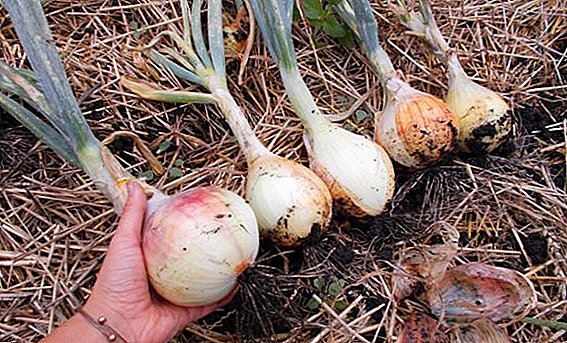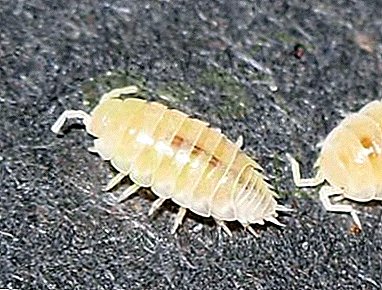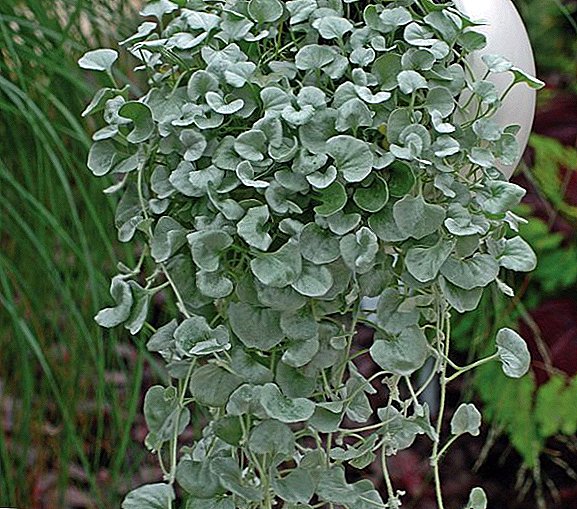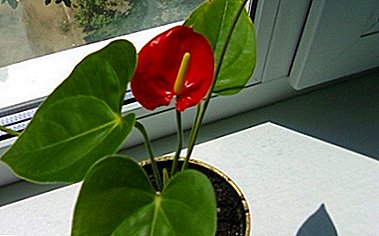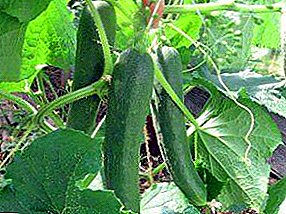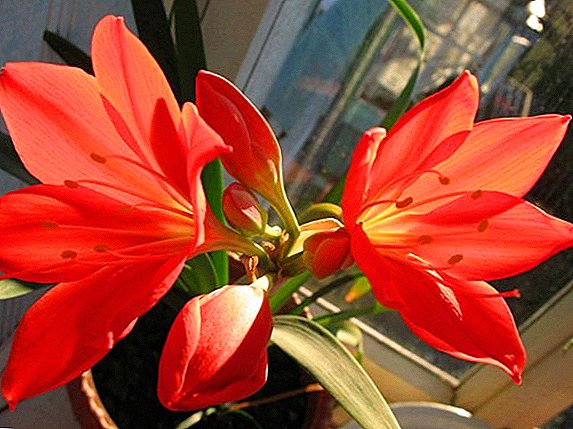 The graceful tropical vallota flower with bright saturated purple color will be an amazing decoration in any home. The plant is completely unpretentious in the care, does not require special conditions of habitat, so it is easy to grow at home.
The graceful tropical vallota flower with bright saturated purple color will be an amazing decoration in any home. The plant is completely unpretentious in the care, does not require special conditions of habitat, so it is easy to grow at home.
Description
Vallota, or as it is also called the "fire lily", is a bulbous tropical plant of the Amaryllid family, which is home to South Africa. The main feature of exotic is considered bright purple leaf color at the base of the stem. The bulbs are also unusual; they have a massive neck that does not have a border with the body of the onion itself. If you remove the top layer of scales, an incredible play of colors opens up before your eyes: the color of the onion changes from light to low to dark pink from above.
Did you know? The plant is properly called "vallot" and not "valotta". It received its name in honor of the botanist from France, Pierre Vallo, who first described a tropical species. Although Latin is written Valotta.Vallota has long, flat, narrow leaves, the length of which can vary from 25 to 40 cm. The foliage of the plant is collected in faith-like bunches, which gives the room flower an exclusive appearance. The fire lily blooms once a year. Subject to the rules of its maintenance and maintaining a comfortable microclimate, flowering can be observed up to two times a year. During flowering from the bulb grows a thick stalk on which the inflorescences are formed.
Read also about such unusual flowers as sundew, passionflower, nepentes, orchis, hoya, camellia and amorphofallus.The flower resembles the shape of a star; it has six tubular petals, in the middle of which there are long stamens and anthers of an oval shape and yellow color. On one peduncle can ripen up to 9 flowers, which after pollination form in the seed box. Keep the flowers on the plant for long - 5-6 days. In nature, exotic is found in a single form - vallota purple. It can be found in the humid tropics in South America, South Africa (the Cape Province).
Kinds
The genus Wallots has over 60 species, among which only four are the most popular:
- purple: has a belt-like leaves of a small size of a noble olive color, length - up to 30 cm. Flowering time falls in early autumn. During this period, a thick stem with inflorescences-umbrellas with a diameter of 5-6 cm appears on the plant. Petals of an oval shape with a slight taper on the tip have a rich red color. After flowering, the flower is transformed into a seed box of black color;
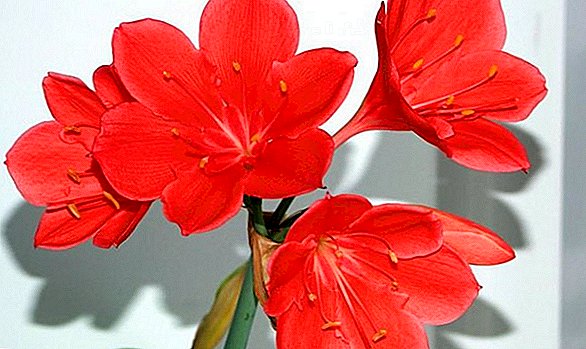
- beautiful: it is characterized by long, narrow leaves of dark green color, up to 45 cm long and oval, symmetrical, slightly pointed to the edge flowers of various shades - from pale pink to red and scarlet. Only the bulbs that have reached a size of 3.5 cm are blooming. 6 petals, 8 cm long, are formed in one bud;
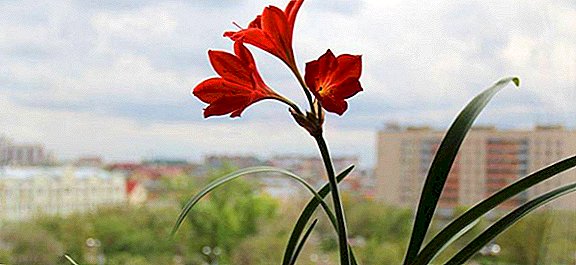
- white: very similar to white lily, which is why they are often confused. The distinctive qualities of this species are the sword-shaped bright green leaves and flowers of a delicate beige shade. The plant blooms in spring or autumn. On the appeared thick peduncle, about 40 cm long, 5-7 flowers are formed;
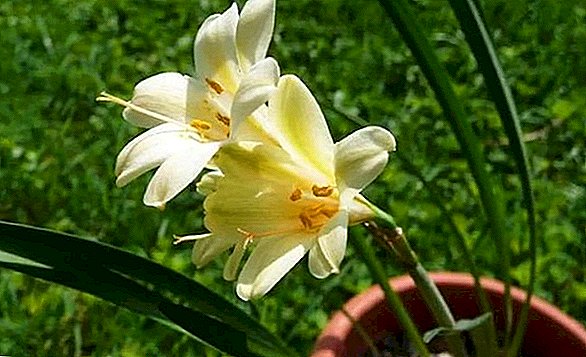
- pink: most rare species. According to external signs, it is similar to the previous one, it has the same bright green leaves in the shape of a sword, however, the flower has a very delicate, pink shade.

Plant Care
Vallota - culture unpretentious and non-capricious care. By following the simple rules of its content, you can grow a beautiful, tropical plant with a rich, bright flowering.
Lighting
First of all, the flower should provide good lighting. Since he comes from the tropics, he loves bright light, especially in need of sunlight in the morning and evening. For the location of the fiery lily, windowsills on the southeast or southwest sides of the house are perfect.
Gardeners often grow flowers such as Surfinia, Begonia, Pelargonium, Calibrachoa, Marigolds, Dahlia, Hortensia, Zinnia, Lobelia, Chrysanthemum, Geranium, Peony, Lily and Tulip.Excessive exposure of the plant to the sun and direct exposure to UV rays are not recommended for a delicate flower, as it can burn. At installation of a pot on northern window sills additional lighting will be required.

Temperature
To achieve double flowering vallota, it is necessary to ensure a comfortable temperature. In the period of its dynamic growth (in the summer time), the optimum temperature is from +20 to +25 degrees.
Important! It is strictly forbidden to give culture a sharp temperature drop, as it may die.In winter, the temperature is reduced to + 10 ... +12 degrees, the lower limit of +5 degrees is allowed. A lower score may cause the root system of the wallot to freeze and die. After the exotic stops blooming, it hibernates, the duration of which is about two months.
The soil
Onion crops need nutrient soil. The soil can be bought in special shops or prepared independently, taking sod land, hardwood soil, humus and sand, in the ratio 3: 2: 1: 1. It is obligatory to form a drainage layer at the bottom of the tank, where the plant will grow. 
Watering
When moistening the flower should not allow overflow. Summer requires moderate watering, the frequency of which is determined by the drying of the top layer of soil. Winter watering is recommended to minimize. During crop irrigation it is important to maintain balance and moisten it as the soil dries. Drain the plant is not worth it, because it can hibernate prematurely and reset the foliage.
Humidity
The plant is not particularly demanding on moisture. The optimum moisture level is about 60%. In extreme heat, it is recommended to irrigate the leaves of the crop with a spray bottle. It is necessary to carry out such moistening when the flower is in the shade, because under the influence of the sun burns can occur on the leaves, in the form of yellow or brown spots. 
Did you know? The earth’s atmosphere contains such a quantity of moisture that it could be enough to cover the entire planet with a layer of water of more than two meters high..
Top dressing
The process of feeding begins in the spring and ends with the last flowering. As fertilizers suitable minerals, specifically designed for flowering houseplants. You can also use bulbs for substrates. Fertilize the flower should be once in 18-20 days. By the end of October, feeding is stopped, although some flower growers are advised to increase the intervals between fertilization and continue feeding the crop until spring.
Read the rules of feeding roses.
Pruning
The plant does not need pruning. After flowering, it prepares for winter, sheds leaves and hibernates. It is recommended to cut only wilted or dried leaves, as well as the stem, after it dries.
Transfer
As the flower grows, it is necessary to repot it. Young culture is recommended not to touch the first 3-4 years at all. When the bulb grows large, and it becomes cramped, then the pot is needed more spacious. Before transplantation, remove the daughter processes from the bulb, because they take power and drain the mother bulb. The upper part of the bulb is not fully buried in the ground, so that later you can easily remove the formed "kids."  In any case, the soil is depleted over time and loses its nutritional properties, so the plant will have to be repotted regularly. The optimal period is once every 3-5 years. It is better to buy the soil in the store or to cook it yourself from three parts of turf, two parts of hardwood, one part of mullein and one part of sand. Do not forget about the formation of the drainage layer, the raw material for which can be expanded clay, vermiculite, etc.
In any case, the soil is depleted over time and loses its nutritional properties, so the plant will have to be repotted regularly. The optimal period is once every 3-5 years. It is better to buy the soil in the store or to cook it yourself from three parts of turf, two parts of hardwood, one part of mullein and one part of sand. Do not forget about the formation of the drainage layer, the raw material for which can be expanded clay, vermiculite, etc.
Reproduction bulbs ("kids")
The simplest and easiest way of breeding vallots - "kids" -lukovichkami. As a rule, the breeding process is combined with a transplant. To do this, onion is separated from the mother plant and among them only those with their own roots are selected.
Bulbs also reproduce plants such as Babian, Hymenocallis, Fritillaria, Crocus, Drimiopsis and Tulip.
The landing process is simple:
- In a small pot with a diameter of 8-10 cm poured the prepared substrate.
- Onions buried in the ground by two thirds.
- Next, provide the plant with good lighting and comfortable temperature.
- After planting it is not recommended to water the plant too often. Already after 2-3 years you can expect the first flowering.
Important! When working with a flower, you must use personal protective equipment, in particular gloves, because it is poisonous (especially bulbs). When the plant comes into contact with the skin on which there are small wounds, suppuration may occur.
Difficulty growing
Despite the fact that the process of growing and caring for a lot is quite simple, the culture has its whims. The flower does not like too high temperatures (above +25 degrees), so it is better to rearrange it in a cooler place. A frequent problem faced by flower growers, is considered a long absence of flowering.  Its reasons may be too large capacity, the presence of a large number of unseparated "children" on the bulb or the absence of a cool rest period in winter. With the beginning of spring growth, the plant begins to shed its leaves - this is a normal process. But the intense yellowing of the leaves should alert, because it may indicate a variety of pests, including mite or mite.
Its reasons may be too large capacity, the presence of a large number of unseparated "children" on the bulb or the absence of a cool rest period in winter. With the beginning of spring growth, the plant begins to shed its leaves - this is a normal process. But the intense yellowing of the leaves should alert, because it may indicate a variety of pests, including mite or mite.
In such cases, it is necessary to make the treatment of herbs with special preparations. The dark tips of the leaves also signal problems. Leaves can deteriorate due to waterlogging, low temperature, sudden temperature shocks. Then you should adjust the watering and create a favorable indoor microclimate.
Diseases and pests
Sometimes even experienced growers are faced with various plant diseases and pests. Most often the culture is attacked by a spider mite. A white gossamer on the leaves indicates that a tick has settled on them. To get rid of it, you should wash the greens with plenty of warm water or a weak soap solution. With any pests, for example, aphids, shield, mealyworm, it is easy to cope by treating the flower with special preparations-insecticides.  If optimal conditions for keeping crops are violated, such as low temperature, too wet soil, various putrefactive processes may develop, for example, gray mold caused by fungus. It manifests itself in the form of light brown dry spots on the leaves. To combat it, a soap and vitriol solution is used (2 g of copper sulphate and 20 g of soap per 1 l of water) or fungicides (Fitosporin-M) are used.
If optimal conditions for keeping crops are violated, such as low temperature, too wet soil, various putrefactive processes may develop, for example, gray mold caused by fungus. It manifests itself in the form of light brown dry spots on the leaves. To combat it, a soap and vitriol solution is used (2 g of copper sulphate and 20 g of soap per 1 l of water) or fungicides (Fitosporin-M) are used.
Fusarium or red rot affecting the root system is considered a threat to the plant. The onions cease to grow, the leaf plates become small, and the scales begin to rot. Unfortunately, fusarium is detected too late, when almost the entire bulb is infected. In this case, the plant is isolated, and healthy flowers are treated with special means - "Fundazol".  Vallota is a bright, beautiful, exotic plant that is able to take a worthy place in the collection of home plants. Despite its external fragility and tenderness, it is undemanding to care and does not need special conditions. Adhering to simple rules, at home you can grow a wonderful culture, pleasing the eye with lush and rich blooms.
Vallota is a bright, beautiful, exotic plant that is able to take a worthy place in the collection of home plants. Despite its external fragility and tenderness, it is undemanding to care and does not need special conditions. Adhering to simple rules, at home you can grow a wonderful culture, pleasing the eye with lush and rich blooms.
Reviews from the network:
I unfortunately can not yet boast the blooming Vallota, it is still very small, but when I had a beautiful blooming Vallota, until I made gross mistakes during her transplantation and did not destroy her. From her, I left only the little kids-onions.Natalie
//floralworld.ru/forum/index.php?topic=1391.msg17256#msg17256
Vallota belongs to the Amaryllis family, blooms long from June to October. When planting, it is important that the upper part of the bulb is above the surface, watering is moderate, during the winter period it needs a rest period, at this time it is necessary to reduce watering and temperature, it’s impossible to allow the leaves to die completely. It is necessary to replant no more than 1 time in 2-3 years. If the conditions of planting and maintenance you have exactly such, then your vallota should bloom.Medic
//indasad.ru/forum/27-uchod-za-komnatnimi-rasteniyami/6425-podskazhite-pochemu-ne-tsvetjot-moj-tsvetok#6434
Valotta stands on the east window, we have 1 floor and the sun is not too much. A year ago, the children were flooded very strongly, and in the spring I spread her. Probably very warm winter is to blame, and the fact that we put the double-glazed windows, and the temperature has significantly increased on the windowsill. Sits in a pot of 14 cm in diameter, a large onion and pieces of 5 tiny children with leaves. Watering as the land dries. At the very beginning of spring, all the flowers were transferred to the GREENWORLD fertilizer in the sticks, otherwise I forget to feed them. Well, I also regularly looked into the pot and asked her to bloom, and it helped! : DValda
//forum.bestflowers.ru/t/valotta.1605/#post-106545






